While quartz, granite, and marble countertops are popular with designers, concrete remains a desirable option on the periphery, offering flexibility and a creative potential that other materials simply cannot provide. If a client is looking for a stand-out kitchen centerpiece, a custom concrete countertop is an option that puts all the control in your hands.
Countertops can define the personality of a kitchen and are a homeowner favorite: In the 2020 Houzz Kitchen Trends Study, countertops were the number one renovation, included in 89 percent of projects. Quartz, granite, and butcher block countertops topped the list for the most popular materials, concrete kitchen countertops offer a unique design opportunity. Because the countertops are poured rather than mined from slabs of rock, concrete is not bound to the traditional slab layout and can feature sculpture-like forms, embedded bits and bobs, and ergonomic design elements.
READ MORE: 5 ALTERNATIVES TO CONCRETE COUNTERTOPS

Concrete Countertop by Cheng Design COPYRIGHT © ROBERT VINCENT
READ MORE: WOOD COUNTERTOPS ARE GREAT BUT REQUIRE SPECIAL MAINTENANCE
If you tried using concrete kitchen countertops in the early 2000s and found the process confusing and the final product messy, Fu-Tung Cheng, founder and principal of Cheng Design, says take another look. Though he now designs houses, he got his start in the kitchen and bath industry. To this day, concrete remains his design hallmark, and in 2002, he literally wrote the book on the topic: “Concrete Countertops: Designs, Forms and Finishes for the New Kitchen and Bath (Taunton Press),” which has sold more than 300,000 copies. Since the book’s publication, a lot has changed.
“We were pouring these big, thick, heavy traditional concrete which you have to build up a little thickness to build strength,” Cheng says. “Now, in the last 20 years with the evolution of concrete technology, we can pour thinner and actually spray concrete onto surfaces and make these beautiful concrete shapes that expand what you can do with it.”
Although they cannot be beat for design options, concrete countertops do not come without their limitations. Cheng warns that it is not just a “substitute marble.” Before specifying one, builders and designers should become well-versed in the pros and cons of concrete countertops.
Here are 7 things you should know before pouring the cement:
Get creative—but don’t get crazy
The fun of concrete is that it is unbound by the limitations other harvested materials such as granite, marble, and quartz have. Concrete can be dyed most colors, poured to any size and shape, and inlaid with materials that can create patterns under its surface.
“You can put shells, glass, metals,” Jose Silvas, sales and marketing representative for Smooth-On, the parent company of the popular concrete manufacturer Buddy Rhodes, says. “It has this unique beauty, and people are really creative, especially in the U.S.”
But Cheng warns to not go too extravagant and take away from the natural beauty of concrete. “I’m not a big proponent of bright colors. I’ve always felt that the beauty of concrete is that it’s a neutral,” Cheng says. Electric yellows, bright pinks are not his style. Instead, designers and builders should choose colors and styles that are timeless so that the countertop works even as trends come and go.
READ MORE: 9 WORKSTATIONS THAT DO MUCH MORE THAN A STANDARD SINK
On the other hand, professionals interested in concrete kitchen countertops shouldn’t shy away from getting creative with the inlays and colors. Cheng says that builders can include more stones in the concrete mix and then polish the surface to really bring out the stones’ properties. For colors that will stand out without phasing out of style, there are also many options.
“You shouldn’t add colors that would stand out in a riverbed, but you can have beautiful shades of off-reds, blues, purples, and all of them look good and natural,” Cheng says.
Concrete countertops can fit any style and have many functions
Though both Silvas and Cheng note that modern styles dominate the concrete countertop trend, the versatility of concrete allows designers to get creative. Designing a rounded bull-nose countertop can create a soft contemporary look, while including etch details to simulate the molding of a cabinet door frame will emulate more classical or colonial styles.
Builders can choose to combine concrete with different materials as well. “Concrete is linked to the concept of organic things, like wood, like metal, that are also trending right now” Silva says. “People combine the concrete with the woods and metals.”
Designers can take that concept even further by designing the countertop specifically for cooking in the kitchen. “A flat countertop is not the best surface to do the needed tasks,” Silvas explains. Instead, special places can be created right on the countertop for cutting boards, integrated bowls, and other kitchen essentials, or a designer can use other inlaid materials such as granite to act as a safe cutting surface. The concrete itself can also be shaped to make life easier in the kitchen: For example, a countertop with an intentional sloping effect towards a sink allows home chefs to position their cutting boards toward the sink to push the chopped food into a waiting bowl without creating a mess.
Concrete countertop with integrated bar by CustomCreteWerks
READ MORE: 11 Products That Prove the Drain Is Disappearing
Concrete countertops grace kitchens in both high-end and affordable homes
Some of the homes that Cheng designed have sold for $13 million, and he loves to use concrete to form one-of-a-kind countertops that stand out.
“When you have something real and massive but at the same time artfully sculpted, people generally respond well to it,” Cheng says. “My architectural clients want something special and unique. They want something that you can’t buy at ikea.”
But unlike other luxury materials such as marble, concrete also lives at the other end of the spectrum. The same ingredients that give concrete the versatility that allows for sculpture-like products are also not that expensive. Crafty homeowners can make low-cost, DIY-concrete slabs to give their kitchens a modern look. The first countertop Cheng ever made was for his first home he lived in after graduating from college. “I couldn’t even afford formica,” Cheng says. “I was just a poor art graduate student from UC Berkeley who had nothing. I had no job, no career path. [Concrete] is a material that has a low entry-point.”
Unlike other materials that need special tools, people can make a countertop with just an aggregate, cement, and casting materials, according to Silvas. He says that within two weeks, someone will be able to finish the countertop and allow for the five days of curing. However, there are some special considerations when making your own. “You must cover it at least for five days with plastic material and probably a blanket to maintain the ideal temperature and keep the humidity of the process in a stable state so you don’t have an excess of evaporation,” Silvas says.
READ MORE: 9 Apron-Front Sinks for Your Farmhouse Kitchens
Concrete countertops require maintenance
Concrete countertops are not for everyone. Cheng says builders should really sit down with a client and pick their brains: Do they really want concrete because they’ve seen it before and like the feel, the look, and the functionality? If not, he says it may be better to steer them toward a more traditional choice due to concrete’s regular maintenance needs and sensitivity to stains and damage. If a homeowner cuts on a concrete countertop, it can dull the knife as well as damage the counter. And because of concrete’s porous properties, it can stain.
“Unsealed concrete will just blotch and stain and the first tomato or lemon you leave on the surface will just eat right through that layer and it will actually etch the concrete,” Cheng says. “You absolutely will want to seal the concrete. That said, the holy grail of concrete sealers has not been discovered.”
Silvas says that concrete countertops last as long as other countertops, but that “it’s like wearing a silk tile instead of a polyester tie.” While polyester can be thrown in a washing machine, silk needs special care, and homeowners of concrete countertops must be careful and mindful to extend the life of the surface.
READ MORE: KOHLER DEBUTS VOICE-ACTIVATED SMART FAUCET
Two main sealants dominate the concrete countertop scene
There are two main kinds of sealers that Cheng lists: an acrylic-based sealant and a topical, spray-on sealer that must cure. Which sealant a professional chooses depends on what kind of upkeep the homeowner feels they can deal with.
If they choose the acrylic-based sealant, they must reseal it every year, but the process is a simple application on the counter’s surface. Cheng recommends waxing the surface to further protect the concrete countertop and prolong the time in between resealing.
On the other hand, the spray-on sealants must cure for at least five days but only need updating every five years or so. Resealing requires a more in-depth process that includes tearing up the old sealant, replacing it, and re-curing it, during which Cheng says the countertop emits harsh off-gassing.
READ MORE: 5 ECO-FRIENDLY COUNTERTOPS THAT ADD BEAUTY WITH A SUSTAINABLE FLAIR
For those who are looking for a concrete-countertop look without the maintenance, there are some options that come pre-finished. IceStone, which is made from cement and recycled glass, receives a treatment that keeps upkeep to a minimum. “The treatment that is applied to IceStone before it leaves the factory eliminates the need to seal it ever again,” IceStone says. “The treatment also has increased IceStone's stain and heat resistance, and UV stability.”
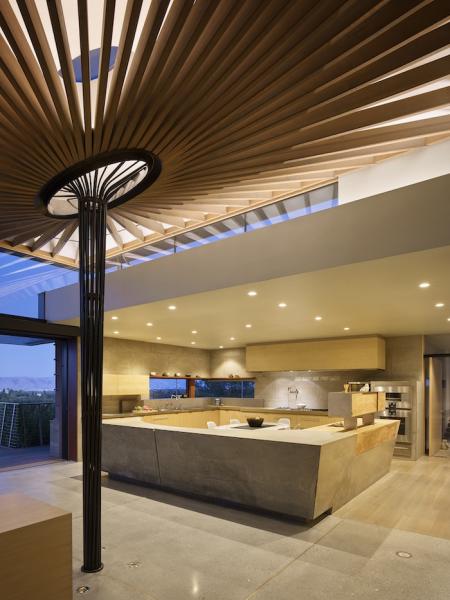
Cheng Concrete Countertop "Ascension" COPYRIGHT © MATTHEW MILLMAN PHOTOGRAPHY
Not all concrete is the same
Concrete countertops usually do not look like someone threw a sidewalk on top of a kitchen island, and the difference doesn't just come from design. The concrete itself is different, according to Cheng. The concrete used for sidewalks and fence posts has a higher ratio of rocks with less sand compared to the kind used for concrete countertops. High-quality materials come in a wide variety of ratings with various additives that change the properties of the concrete. The higher the rating, which is measured in pounds per square inch (psi), the stronger the countertop.
“Some of them have polymers, which have a type of plastic added to them,” Cheng says. “Then there are rapid set concretes that set up really quickly and hard and that’s why you kind of have to know what you’re doing if you're going to try to get involved with a more sophisticated countertop.”
For less complicated projects or those with limited experience, he suggests using a high-quality concrete of 5,000 psi without any additives. With that rating and the simple formula of sand, rocks, cement, and water, builders will get a strong product that isn’t too complicated to use.
READ MORE: HOW TO INSTALL KITCHEN CABINETS THE RIGHT WAY
Know what you’re doing or hire someone who does
Though DIY concrete countertop tutorials run rampant on YouTube, Cheng says that professional concrete countertop contractors are the way to go if you do not have experience working with the medium, especially if a client wants something more complicated than a slab. Between choosing the right materials, forming and setting the concrete countertop, and curing the surface, there are a number of places to get the process wrong. But he doesn’t want to discourage builders from trying their hand at learning the craft by starting on smaller projects.
“If you can’t afford Caesarstone and all the other materials out there, or you don’t like the look, explore making concrete surfaces yourself,” Cheng says. “It’s fun and you can start out really modestly by making a slab for a bathroom vanity countertop and graduate to a kitchen.”
READ MORE: WHAT IS THE DIFFERENCE BETWEEN CUSTOM, SEMI-CUSTOM CABINETS?

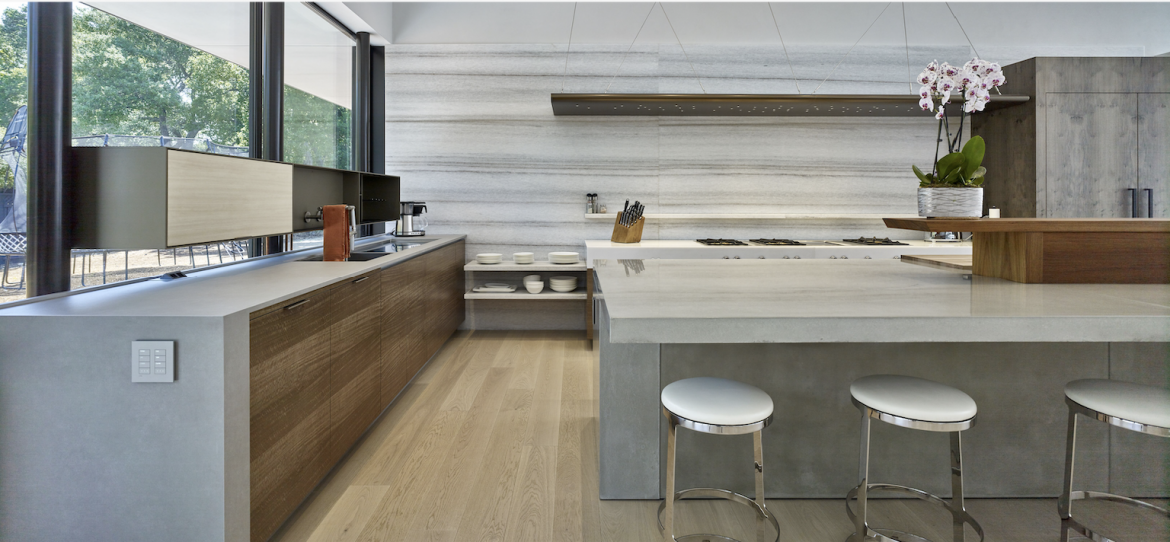
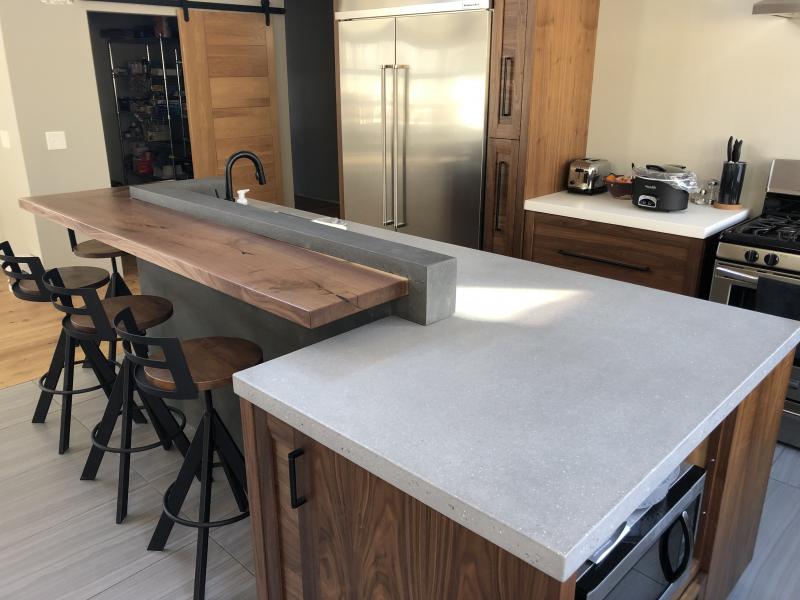

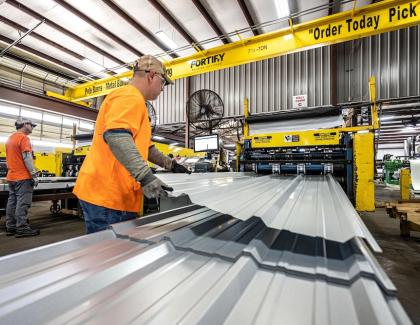
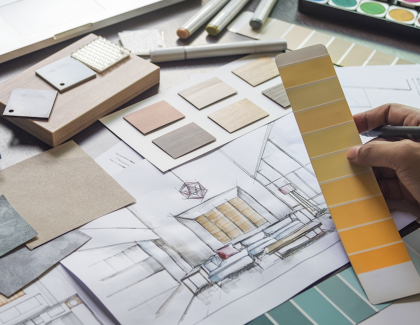
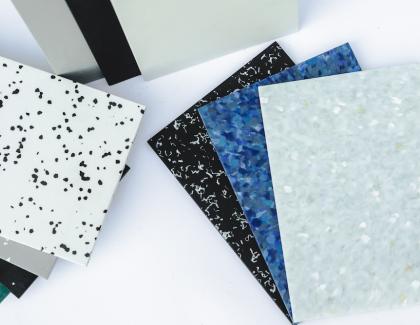
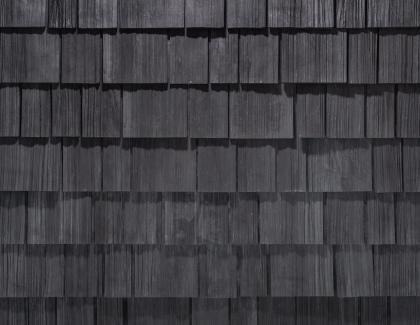
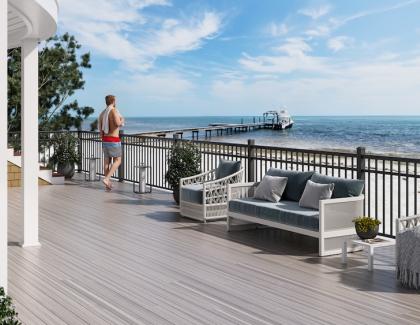
Add new comment